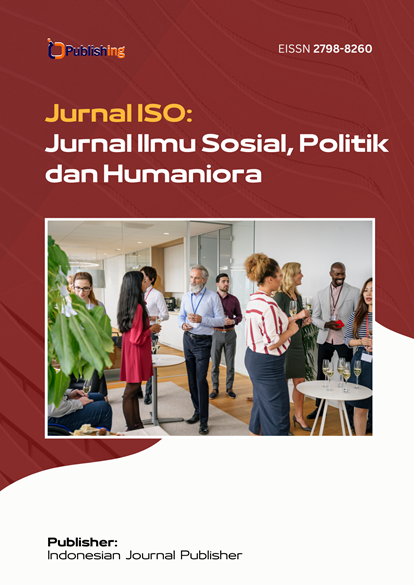Pelapisan Sosial pada Masyarakat Desa Pulau Mungkur Kecamatan Gunung Toar Kabupaten Kuantan Singingi
DOI:
https://doi.org/10.53697/iso.v4i2.2052Keywords:
Social Stratification, Social Strata, Social CriteriaAbstract
It is undeniable that the gap in life makes a multi-layered form in society, we can find this in any community, one of which is in the community in the village of Mungkur Island. This can be seen in the daily life of its citizens, such as when the community gathers, among them there will be one or more people who are respected because of the level of education they have and because the economic level they have is better than other people. The purpose of this study is to find out which criteria are the most dominant in determining social stratification in society and to see the relationship between social stratification criteria and strata in society in Mungkur Island Village. The method in this study is quantitative inferential. The population of this study is 243, the research sample is housewives or heads of households. The data collection techniques used are questionnaires, observations and documentation. Based on the results of the study, the score for the wealth criterion was obtained 1,207, for the wealth criterion a score of 1,449, for the wealth criterion a score of 1,607, for the wealth criterion a score of 1,892. And for the relationship between wealth and social strata 0.66, the relationship between power and social strata 0.73, the relationship between honor and social strata 0.6 and the relationship between education and social strata 0.83. It can be concluded that there is no most dominant criterion among the four social stratification criteria, it turns out that these four criteria have the same strength, namely strong in Mungkur Island Village and the four social stratification criteria have an influence on social strata in society, but education has a greater influence.
References
Dynela Gabriela Korompis. 2023. “Stratifikasi Sosial Di Pedesaan Kolongan (Studi Analisis Terhadap Adanya Perbedaan Golongan).” 3(2):1–7.
Everett Rogers. 1987. Perubahan Sosial Dalam Masyarakat Pedesaan. edited by penterjemah Alimandan.Rajawali Press
Hidir, Achmad dan Rahman Malik (2024). Teori Sosiologi Modern. Yayasan Tri Edukasi Ilmiah
Irianto Agus. 2006. Statistik Dan Konsep Dasar Aplikasinya. Pertama. Jakarta: Kencana Prenada Media.
Mita Rosaliza. 2004. “Stratifikasi Sosial Di Perkotaan Studi Di Kelurahan Kota Bengkalis Kecamtan Bengkalis.” Universitas Riau.
Riduwan. 2016. Pengantar Statistik Sosial. Bandung: Alfabeta.
Samuel Michael Wattimury, Nur’aeni Marta, and Abrar. 2022. “Sistem Stratifikasi Sosial Pada Masyarakat Kisar Kabupaten Maluku Barat Daya.” Fikri : Jurnal Kajian Agama, Sosial Dan Budaya 7(2):184–94. doi: 10.25217/jf.v7i2.2935.
Svalastoga, Kaare. 1989. Diferensiasi Sosial. Jakarta: Pt.Bina Aksara.
Taneko, Soleman. 1993. Struktur Dan Proses Sosial Suatu Pengantar Sosiologi Pembangunan. JAKARTA: PT Raja Grafindo Persada.
Belyaeva, L. (2022). CHANCES AND RISKS AS CRITERIA FOR SOCIAL STRATIFICATION OF MODERN RUSSIAN SOCIETY. Sotsiologicheskie Issledovaniya, 2022(11), 165–170. https://doi.org/10.31857/S013216250021522-7
Chica-Olmo, J. (2020). Assessing Colombia’s policy of socio-economic stratification: An intra-city study of self-reported quality of life. Cities, 97. https://doi.org/10.1016/j.cities.2019.102560
Dynela Gabriela Korompis. (2023). Stratifikasi Sosial Di Pedesaan Kolongan (Studi Analisis Terhadap Adanya Perbedaan Golongan). 3(2), 1–7.
Eder, A. (2018). On the apparent paradox of belonging to the middle strata of society. A quantitative and qualitative analysis of the austrians’ subjective social position from 1993 to 2016. SWS - Rundschau, 58(2), 203–224.
Everett Rogers. (1960). Perubahan Sosial Dalam Masyarakat Pedesaan (penterjemah Alimandan (ed.)).
Faqihi, F. (2020). A pilot study of therapeutic plasma exchange for serious SARS CoV-2 disease (COVID-19): A structured summary of a randomized controlled trial study protocol. Trials, 21(1). https://doi.org/10.1186/s13063-020-04454-4
Gallestey, J. B. (2022). Social Inequalities in COVID-19. Moving from COVID-19 Mathematical Models to Vaccine Design: Theory, Practice and Experiences, 318–384.
Hakansson, T. (2019). Socioeconomic stratification and marriage payments: Elite marriage and bridewealth among the Gusii of Kenya. Social Change and Applied Anthropology: Essays In Honor of David W. Brokensha, 164–181. https://doi.org/10.4324/9780429306211-15
Irianto Agus. (2006). Statistik dan Konsep Dasar Aplikasinya (Pertama). Kencana Prenada Media.
Lushnikov, D. A. (2016). Revisiting the criteria and indicators for identifying the middle class within contemporary russian society (before the Social and Economic Crisis of 2014). Oriental Studies, 26(4), 192–200. https://doi.org/10.22162/2075-7794-2016-26-4-192-200
Maleva, T. M. (2019). Territorial Mobility of the Russian Population in the Context of Social Dynamics. Regional Research of Russia, 9(4), 350–358. https://doi.org/10.1134/S2079970519040075
Mareeva, S. V. (2021). Middle class perceptions of inequality compared to other russians: Consensus or disagreement? Sotsiologicheskie Issledovaniya, 2021(2), 38–49. https://doi.org/10.31857/s013216250013820-5
Melin, H. (2016). Class Analysis in the USSR and Contemporary Russia. Rethinking Class in Russia, 23–41. https://doi.org/10.4324/9781315605982-2
Mita Rosaliza. (2004). STRATIFIKASI SOSIAL DI PERKOTAAN STUDI DI KELURAHAN KOTA BENGKALIS KECAMTAN BENGKALIS. UNIVERSITAS RIAU.
Orhan, S. (2023). The Past, Present and Future of Social Stratification from Said Nursi’s Perspective. Journal of Muslims in Europe, 8(2), 1–27. https://doi.org/10.1163/22117954-bja10085
Padilla-Rodríguez, J. C. (2021). Malaria risk stratification in Colombia 2010 to 2019. PLoS ONE, 16(3). https://doi.org/10.1371/journal.pone.0247811
Prokazina, N. V. (2020). Differentition of the quality of life in the regional space. RUDN Journal of Sociology, 20(3), 509–526. https://doi.org/10.22363/2313-2272-2020-20-3-509-526
Riduwan. (2016). Pengantar Statistik Sosial. ALFABETA.
Samuel Michael Wattimury, Nur’aeni Marta, & Abrar. (2022). Sistem Stratifikasi Sosial Pada Masyarakat Kisar Kabupaten Maluku Barat Daya. Fikri : Jurnal Kajian Agama, Sosial Dan Budaya, 7(2), 184–194. https://doi.org/10.25217/jf.v7i2.2935
Stratifikasi, A., Anjereuw, K., Samofa, D., Biak, K., Stratifikasi, D., Dalam, S., Bermasyarakat, K., Kampung, D., Distrik, M., Kabupaten, S., Numfor, B., & Kunci, K. (2021). Copi susu : 3(2), 29–35.
Svalastoga, K. (1989). DIFERENSIASI SOSIAL. PT.BINA AKSARA.
Taneko, S. (1993). Struktur dan Proses Sosial Suatu Pengantar Sosiologi Pembangunan. PT Raja Grafindo Persada.
Downloads
Published
How to Cite
Issue
Section
License
Copyright (c) 2024 Widiya Natasari, Hesti Asriwandari

This work is licensed under a Creative Commons Attribution 4.0 International License.













